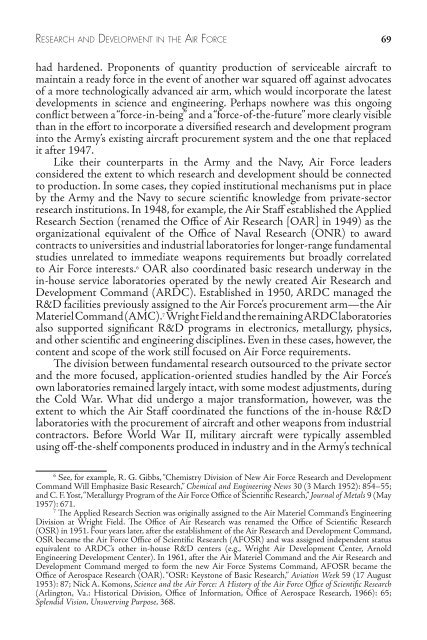To download as a PDF click here - US Army Center Of Military History
To download as a PDF click here - US Army Center Of Military History
To download as a PDF click here - US Army Center Of Military History
You also want an ePaper? Increase the reach of your titles
YUMPU automatically turns print PDFs into web optimized ePapers that Google loves.
ReseaRch a n d developmenT In T h e aIR fo R c e 69<br />
had hardened. Proponents of quantity production of serviceable aircraft to<br />
maintain a ready force in the event of another war squared off against advocates<br />
of a more technologically advanced air arm, which would incorporate the latest<br />
developments in science and engineering. Perhaps now<strong>here</strong> w<strong>as</strong> this ongoing<br />
conflict between a “force-in-being” and a “force-of-the-future” more clearly visible<br />
than in the effort to incorporate a diversified research and development program<br />
into the <strong>Army</strong>’s existing aircraft procurement system and the one that replaced<br />
it after 1947.<br />
Like their counterparts in the <strong>Army</strong> and the Navy, Air Force leaders<br />
considered the extent to which research and development should be connected<br />
to production. In some c<strong>as</strong>es, they copied institutional mechanisms put in place<br />
by the <strong>Army</strong> and the Navy to secure scientific knowledge from private-sector<br />
research institutions. In 1948, for example, the Air Staff established the Applied<br />
Research Section (renamed the <strong>Of</strong>fice of Air Research [OAR] in 1949) <strong>as</strong> the<br />
organizational equivalent of the <strong>Of</strong>fice of Naval Research (ONR) to award<br />
contracts to universities and industrial laboratories for longer-range fundamental<br />
studies unrelated to immediate weapons requirements but broadly correlated<br />
to Air Force interests. 6 OAR also coordinated b<strong>as</strong>ic research underway in the<br />
in-house service laboratories operated by the newly created Air Research and<br />
Development Command (ARDC). Established in 1950, ARDC managed the<br />
R&D facilities previously <strong>as</strong>signed to the Air Force’s procurement arm—the Air<br />
Materiel Command (AMC). 7 Wright Field and the remaining ARDC laboratories<br />
also supported significant R&D programs in electronics, metallurgy, physics,<br />
and other scientific and engineering disciplines. Even in these c<strong>as</strong>es, however, the<br />
content and scope of the work still focused on Air Force requirements.<br />
The division between fundamental research outsourced to the private sector<br />
and the more focused, application-oriented studies handled by the Air Force’s<br />
own laboratories remained largely intact, with some modest adjustments, during<br />
the Cold War. What did undergo a major transformation, however, w<strong>as</strong> the<br />
extent to which the Air Staff coordinated the functions of the in-house R&D<br />
laboratories with the procurement of aircraft and other weapons from industrial<br />
contractors. Before World War II, military aircraft were typically <strong>as</strong>sembled<br />
using off-the-shelf components produced in industry and in the <strong>Army</strong>’s technical<br />
6 See, for example, R. G. Gibbs, “Chemistry Division of New Air Force Research and Development<br />
Command Will Emph<strong>as</strong>ize B<strong>as</strong>ic Research,” Chemical and Engineering News 30 (3 March 1952): 854–55;<br />
and C. F. Yost, “Metallurgy Program of the Air Force <strong>Of</strong>fice of Scientific Research,” Journal of Metals 9 (May<br />
1957): 671.<br />
7 The Applied Research Section w<strong>as</strong> originally <strong>as</strong>signed to the Air Materiel Command’s Engineering<br />
Division at Wright Field. The <strong>Of</strong>fice of Air Research w<strong>as</strong> renamed the <strong>Of</strong>fice of Scientific Research<br />
(OSR) in 1951. Four years later, after the establishment of the Air Research and Development Command,<br />
OSR became the Air Force <strong>Of</strong>fice of Scientific Research (AFOSR) and w<strong>as</strong> <strong>as</strong>signed independent status<br />
equivalent to ARDC’s other in-house R&D centers (e.g., Wright Air Development <strong>Center</strong>, Arnold<br />
Engineering Development <strong>Center</strong>). In 1961, after the Air Materiel Command and the Air Research and<br />
Development Command merged to form the new Air Force Systems Command, AFOSR became the<br />
<strong>Of</strong>fice of Aerospace Research (OAR). “OSR: Keystone of B<strong>as</strong>ic Research,” Aviation Week 59 (17 August<br />
1953): 87; Nick A. Komons, Science and the Air Force: A <strong>History</strong> of the Air Force <strong>Of</strong>fice of Scientific Research<br />
(Arlington, Va.: Historical Division, <strong>Of</strong>fice of Information, <strong>Of</strong>fice of Aerospace Research, 1966): 65;<br />
Splendid Vision, Unswerving Purpose, 368.

















